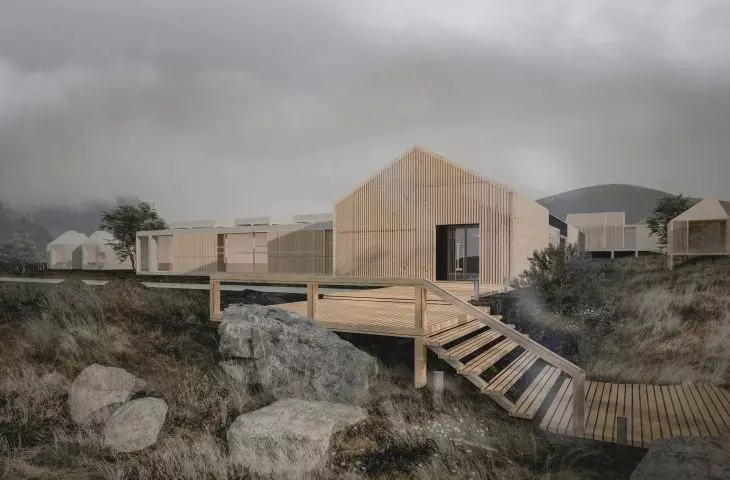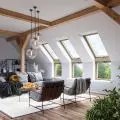Work submitted for the competition
"Best Interior Diploma 2022/2024".
The idea of the project is to improve the quality of stay in mental health centers in Poland, to curb the stigmatization of people suffering from mental disorders and to change the stereotypical thinking about psychiatric hospitals as sad penitentiaries, building their image as patient-friendly places that allow quick recovery. The designed complex, inspired by the concept of a garden city in the Silesian Beskids, is located in a charming village surrounded by mountains.
ChAD and depression treatment center in the Silesian Beskids.
© Magdalena Płachetka
Depression sufferers have very different needs than patients in a state of hypomania/mania, so the wards have been divided into male and female wards for depressed patients and male and female wards for ChAD (bipolar affective disorder) patients in an elevated mood state.
ChAD and depression treatment center in the Silesian Beskids, axonometry
© Magdalena Płachetka
A common area for all patients to integrate socially is also envisaged, which includes rooms for therapeutic activities: for art classes, occupational therapy and group meetings with a therapist, a gym, and a room for yoga classes.
Interior of the reception area
© Magdalena Płachetka
The common area has been separated into a section for visitors, and there is a cafeteria with a restaurant. The main building is designed for patient diagnosis and admission to the ward. It also contains administrative rooms.
plan of the main building
© Magdalena Płachetka
Nature is important in the project, its soothing proximity affecting patients. The search for the form of the building masses led me to create neutral objects with a light structure. I wanted nature to play the most important role in the project, and the objects to form a complement to it. Creating a complex of buildings according to the concept of a garden city served to abandon the stereotypical appearance of a psychiatric hospital as one large compact block, which can be overwhelming.
part of the waiting room
© Magdalena Płachetka
Moving to the therapy rooms is associated with patient activation, and is an opportunity to be outdoors and take a relaxing walk. Separating the common therapeutic activity area from the ward area promotes a sense of privacy and security for patients during their stay in the ward.
cafeteria area
© Magdalena Płachetka
The patients' rooms are single and double rooms with bathroom and terrace. The rooms are decorated minimally, which makes it easier to keep things tidy and protects against overcrowding. This is especially important for patients in the mania and hypomania phases, who are unable to focus and put away and accumulate things in different places, but also for depressed patients who lack the strength and motivation to clean.
interior of the room
© Magdalena Płachetka
An important part of the patient's room is the terrace, which will allow the patient to commune with nature even at night, gives a sense of freedom. Each of them is adjacent to the building on three sides, the side facing the space is enclosed with slats more than 3.5 meters high, making it impossible to escape from the center.
therapeutic activity zone
© Magdalena Płachetka
The final element of the work was to design a garden that has a therapeutic effect on all the senses of the center's residents, as well as to provide an environment conducive to building contacts and supporting the patients' physical activity. The park space includes a green clearing, places for resting in the sun and shade, places for resting in silence and solitude, a place for observing other people, and a place for meeting in a group.
studio
© Magdalena Płachetka
In the park there is a community garden allowing to grow vegetables, fruits and plants during horticulture classes. The sensory effects of the garden consist of designing vegetation to provide visual stimuli by selecting colors and planting them in a static or dynamic composition, creating a garden of smells by selecting fragrant plants, planting fruit trees and plants to provide taste stimuli.
The center, exterior view
© Magdalena Płachetka
Magdalena PŁACHETKA
Illustrations: © Author










































































































